When it comes to heavy metal rocking with a free heel there is no more powerful binding on planet tele than 22 Designs Axl. It is possible to make the TTS or NTN binding more powerful but actually I shudder that you should need any more tele-resistänçe than Axl delivers. Put another way, if you need more tension than this binding adds to your boot, you probably ought to just lock ‘yer heels.
It has taken a few years to prove out but even the minor weaknesses of the most popular backcountry tele binding, BD’s O1 become significant when you factor in the level of power available with the Axl. Hammerhead set the high water mark for an active binding over a decade ago. Axl added a free pivot, but kept the HH DNA with an ingenious adaption of the HH cable routing that allows the touring pivot.This is not to say that Axl doesn’t have some weaknesses of its own. Nothing is perfect, but like O1’s, these imperfections are easy to bear. Besides, who would argue with the combination of Hammerhead power and adjustability with an easy to engage free pivot for earning turns?
Touring Mode
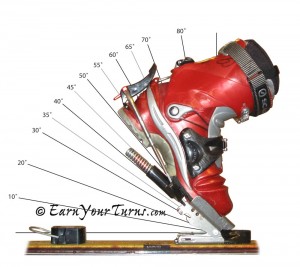
A solid 45° ROM delivers all the freedom you need, with the uncompromised power and adjustability of a Hammerhead.
Icing
However, the AXL can and does ice up. In my experience this is rare, but I don’t doubt the reports that ice can build up on the bottom side of the toeplate, similar to what happens with the O1. The latch still moves, but the toe plate doesn’t get low enough for the latch to grab it. This will require exiting the binding and throwing a few curses at it while you chip the ice off. Rare for me, but YMMV. A dab of silicone grease on the locking tab and heads of the screws should reduce this problem.
A more common phenomenon is for a small bumper of ice to build under the duckbill. Those dang ducks! It reduces an unrestricted 45° range of motion another five degrees, to a noticeably limited 40° ROM. In wet snow this happens a lot. It cleans off easy, but in a perfect world I wouldn’t have to. A minor complaint for the rest of the performance offerings.
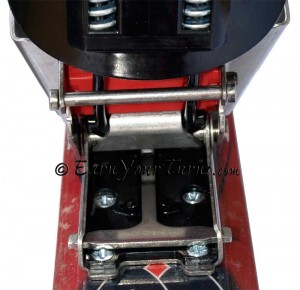
There is still plenty of exposed metal on Axl's underbelly, but it is dramatically improved from v1 or the beta version. With a dab of silicone grease to metal parts icing issues usually disappear.
Pivot Bolt Issue
The locking bolts on the pivot are known to loosen up on pre-2010 versions. If you have this issue, 22 Designs is adamant that you NOT use Loctite™. You will reap bad juju if you do this. Use a slow cure epoxy instead and if possible, a low viscosity epoxy so it easily coats all the threads to really lock it on.
Mode Switch
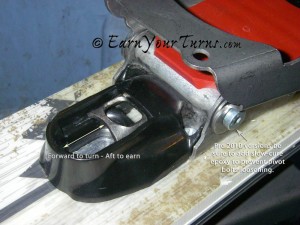
Switching modes is easy with a ski pole. If it gives too much resistance switching back to turn mode, check for ice under the toe plate.
Climbing Peg
For reducing the angle of attack Axl keeps the spring loaded climbing peg design of the Hammerheel. Hands down the easiest climbing peg to engage that I know of. It comes in three heights to provide 1¼” (32 mm), 1¾ (45 mm) or 2¼” (57 mm) of heel lift for flattening out the uphill skin track. The shape of the heel shim is modified to make room for the dual-underfoot springs, but otherwise it’s the same old Hammerheel.
I’ve heard of these U-shaped wires bending while slamming your ski to hold an edge on an icy traverse so it would be nice to see 22 Designs come up with a solution to this. Even so, perhaps merely adjusting skinning technique could resolve this issue too. The other option would be to use ski crampons.
Harscheisen
Perhaps that’s the only item missing from the Axl package – ski crampoons – to make it a complete ski mountaineering package. I’ll bet 22 Designs could do something that hooks on with a longer Slic-pin. (Update 2013: Axl Ski Crampons now available!)
Turning Power
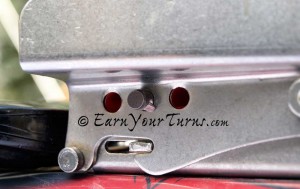
To adjust turn power just push the locking nub and slide the Slic-pin out, then reposition as desired.
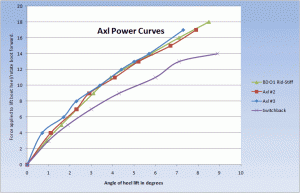
Flex curves for Axl #2 and #3. BD's O1 (rid-stiff) and Voile Switchback for comparison.
Data courtesy Univ. of Idaho © 2009
A number of people have noticed that the tension in the springs of the Axl are rather stiff out of the box, but they will relax a bit after a few days use at a resort. So by all means, do not judge the resistance of these bindings until you’ve logged at least 40k vert of turns on ’em.
Weight
Axl is not the lightest binding on the market, nor is it alone. At four pounds per pair it easily meets the criteria of the bigger is better crowd, not only providing plenty of turning power, but with a dominance of steel in its construction and a minimum of plastic, plus a six-hole mounting pattern, durability is a feature 99% of users can count on.
Mounting Notes
Although 22-Designs was able to keep the six-hole pattern, pin line on the toe plate is shiftedFor the overly aggro skier, despite the reputation for a 6-hole pattern holding up to abuse much better than a 4-hole, I would still recommend using inserts, at least for the two rear mounting holes.
Though a jig is always recommended, a mounting pattern is available as a printable PDF from the 22 Designs website. It is worth it just to use for positioning the heel post correctly so the heel throw tucks behind it, under the climbing peg, when you’re shouldering your skis and don’t want the cable flopping around.
Conclusion
Four buckle boots paired with Axl’s is a no brainer. The effective pivot point of the cable goes from aggressive to radical, for help with flexing a stiff boot. And with smaller, softer boots, Axl simply adds the horsepower a smaller boot lacks. So no matter what boot you have, if you’re driving fat boards fast, Axl delivers the kind of control that says lock in, drop your knee, hold on and shut up! Few skis or conditions can withstand the bridle Axl delivers. With an easy to engage free pivot, Axl’s are ready to go wherever you want to take them. Bumps, cliffs, and powder stashes in bounds, out of bounds or the backside of beyond.
22 Designs
Axl
MSRP: $320
Weight: Standard – 4.0 lbs. (1810 g) • Small – 3.8 lbs. (1724 g)
Size range (mondo): Std for 25.5 or larger, Small for 25.0 or smaller
Riser height: 1.1″ (28 mm) w/2° ramp angle
Optional springs: Stiffy springs ($35)
Axl issues per ttips thread
Axl spring beta per ttips
© 2011



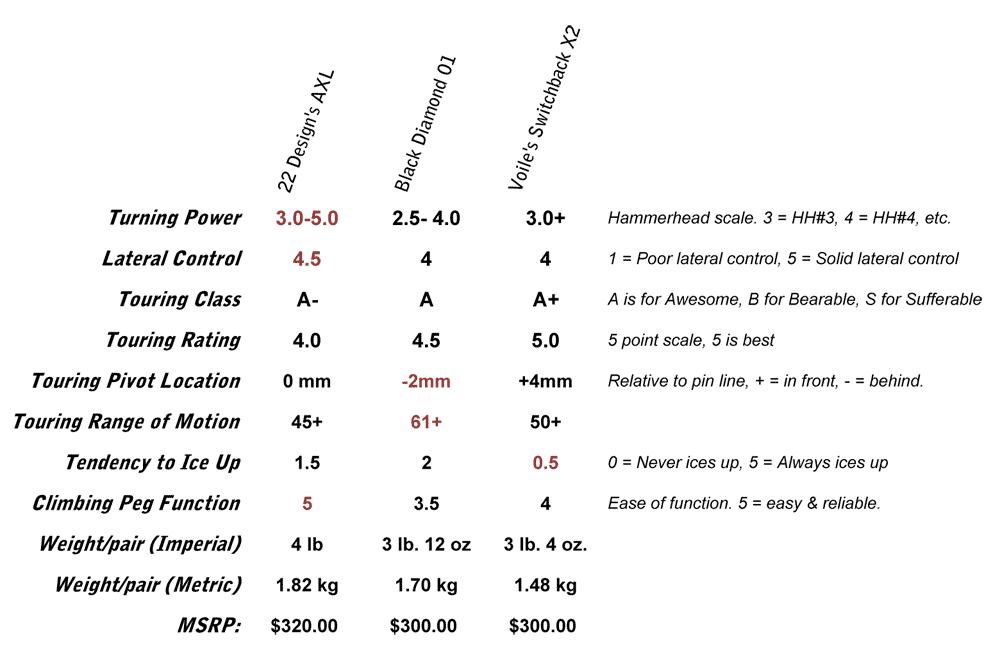
8 comments
9 pings
Skip to comment form
Am I the only person who seems to have noticed that the heel piece (not the climbing wire) is lower relative to the main part of the binding on the Axl than it is on the HH? I’ve measured both. The heels are the same height at 1.25″ on both the HH and the Axl and while the toe plate on the Axl is also 1.25″, it’s only 1″ on the HH. In switching from the HH to Axl, it feels like I’m too far back on my heels. I’ve looked everywhere on the web to see if anyone else has noticed this but I can’t find any comments about it. I’m not liking the difference and may try to fashion a quarter inch shim for the heel on the Axl to make it feel more like the HH.
Why don’t you like the lower heel?
I think the idea with the lower heel is to have an early engagement of the springs. the same thing was done on the new NTN binding, they call it reducing the ramp angle.
I run a lower heel on my TTS (9mm vs 19mm) this allows me to set my preload low, just enough to keep the heel down, then I get instant bellows compression with a slight heel lift.
If the spring actually engaged that soon it might be okay. But, it doesn’t. There’s a short distance in which it feels like it’s just moving to the point where the spring starts to engage so it’s kind of wasted energy up to the point of engagement. Also, it just feels like I’m standing on my heels too much after being used to the ramp angle on Hammerheads.
Ben, have you skied either the Hammerhead or the Axl?
I realize that’s probably a dumb question- I’m sure you have skied both and I’ve read your review of the TTS. But I don’t know if the engagement maybe just feels different when using the Axl springs with the Dyna toe.
Yes, I have skied the Axl and Hammerhead both in 75mm form. I have also skied the Axl with a custom fabricated NTN toe box. I have three Telemark Tech System, one based on the Axl, one based on the Hammerhead, and a Telemark Tech System with a speed toe and Voile X2 cartridges.
I tend to prefer a lower heel as I feel like a high heel reduces the effective range of motion and it’s not as stable as a flat foot when your heel is down. I suppose, more than the absolute heel height, you need to look at relative toe to heel elevation. I like my foot to sit flat, heel and toe at the same elevation off the ski.
You can get HH heels, but keep in mind that the underfoot springs can have clearnace issues with some heels; the Axl heel has the forward screw hole offset from the heel. You can use soem spacer material, like a cutting board, or see if you can find a set of spacers from a HH shift plate.
Thanks for your input, Ben.
I made some heel shims for the Axl heels out of 1/4″ Delrin plastic. I tried them out yesterday and they skied much more like Hammerheads for me. So, in that sense, I was pleased.
But I also tried tightening up the cables on the Axls and that may have made more of a difference than I would have anticipated (I kept the cables on my Hammerheads on the looser side because several years ago I had a heel tube sheer in half while skiing and decided that maybe I had been cranking them down too much). I’ll have to play with the Axl cable tension a bit more to see if that makes enough of a difference without the heel shims.
I had a number of days in on the Axls before I made the shims and it seems that while I was less than satisfied with the heel height while really getting after it, I did find that I’d gotten used to having a lower heel when just riding my boards upright or plowing over uneven terrain. As soon as I put the shims on, I felt a little over the handlebars in those situations. It sounds like that’s why you like the lower heel as well.
I have a broken toe piece on the right. The metal lip that locks over the sliding ski tour adjustment is broken. I’m secure on on side as I ski. What are my options? Can i replace the toe piece? Do I have to get a whole new set of bindings? Can I ski with these in the ski mode?
[…] Review here. […]
[…] 2012 Related Posts: Review of 22 Designs Axl Review of 22 Designs Axl (beta version) Review of 22 Designs Hammerhead (beta version) Share […]
[…] adjustments to the binding through 2012. They created a free-pivoting version of Hammerhead called Axl that maintained the same underfoot cable routing with easier to adjust power pivot points. The […]
[…] you love your current 75mm boots stick with 75mm options like O1, Axl, Enzo, RT Spike, Switchback or the X2 version, and if you must have a safety release, 7tm Power […]
[…] Not much new in tele. Axl is mature and solid, so are the Switchback brothers, and BD’s O1. All decent choices and now […]
[…] excellent skiing control. It combines the control of NTN with the smooth flex of a Hammerhead (Axl/Vice). Based on control and flex alone, the Mantis can be skied as an every day binding. Initially […]
[…] at last years OR show (OR Winter 2012) that they were going to make ski crampons for their renowned AXL binding. I might have overlooked it myself except for the fact that the sample they had in their […]
[…] cable pivot location for tele-resistance on par with HH #3—#5, but not as conveniently as the Axl or Enzo. Once you dial in what power you like the only shifting you will need to do is between tele […]
[…] 22D Axl […]